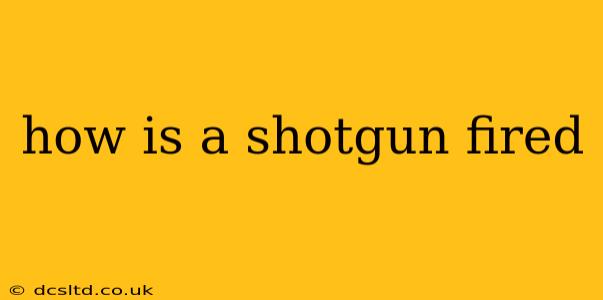Shotguns, known for their powerful blasts and versatility, are fascinating firearms. Understanding how they operate is crucial for safe and responsible handling. This guide breaks down the firing mechanism of a shotgun, addressing common questions and misconceptions.
What Makes a Shotgun Different from Other Firearms?
Unlike rifles and handguns that typically fire a single projectile, shotguns fire a spread of shot (small pellets) or a single slug. This unique characteristic significantly impacts their operation and effectiveness. The design focuses on dispersing projectiles over a wider area, making them effective for close-range hunting or self-defense scenarios.
How the Firing Mechanism Works: A Step-by-Step Guide
The firing process of a shotgun involves several key steps:
-
Loading: The shotgun is loaded with shells, each containing the shot, powder, and primer. The number of shells a shotgun can hold at once depends on its design; some are single-shot, while others are pump-action, semi-automatic, or hold multiple shells in a magazine.
-
Chambering: The process of loading a shell into the firing chamber, where it will be ignited. This varies depending on the type of shotgun; some require manual chambering, while others have mechanisms for automatically feeding and chambering shells.
-
Trigger Pull: Pulling the trigger completes the firing sequence. This action releases the firing pin.
-
Primer Ignition: The firing pin strikes the primer in the shotgun shell. This primer is a small, sensitive explosive that ignites when struck.
-
Powder Ignition: The ignited primer ignites the gunpowder within the shell. The rapid expansion of gases created by the burning gunpowder is the driving force behind launching the shot.
-
Projectile Ejection: The expanding gases propel the shot (or slug) down the barrel of the shotgun at high velocity.
-
Ejection (for some models): In pump-action or semi-automatic shotguns, the spent shell is ejected, ready for the next round.
What Type of Ammunition Do Shotguns Use?
Shotguns use shells, also known as cartridges. These cylindrical casings contain the shot, gunpowder, and primer. The size and type of shell vary significantly, influencing the shot's spread, range, and power. Common shell sizes include 12 gauge, 20 gauge, and .410 bore, each with its own unique characteristics and applications.
How Does the Choke Affect the Shot Pattern?
The choke is a constriction at the end of the shotgun barrel. It affects the shot pattern by controlling how tightly the shot pellets are grouped. Different choke types (e.g., cylinder, modified, full) result in different shot patterns, impacting range and spread.
What are the Different Types of Shotguns?
There are many types of shotguns, each with its mechanism of operation:
- Single-shot: Requires manual loading and unloading after each shot.
- Pump-action: Uses a manually operated sliding pump to eject spent shells and chamber new ones.
- Semi-automatic: Automatically ejects spent shells and loads the next round using gas or recoil energy.
- Break-action: The barrel hinges open to allow for loading and unloading.
Understanding these variations helps determine which shotgun best fits individual needs and preferences.
What Safety Precautions Should I Take When Handling a Shotgun?
Safe handling is paramount when dealing with any firearm. Always treat every shotgun as if it were loaded, never point it at anything you don't intend to shoot, keep your finger off the trigger until ready to fire, and be certain of your target and what's beyond it. Proper training and adherence to safety rules are crucial.
This detailed explanation provides a comprehensive understanding of how a shotgun is fired, emphasizing the process's key elements and safety considerations. Remember that responsible firearm ownership requires thorough knowledge and constant vigilance.
